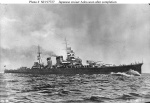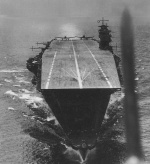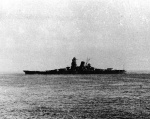Warships in Evangelion
This is the list of World War Two vessels that the characters in the show have been named after. Not meant to be overdone, but enough for a fan to appreciate the history behind the name and perhaps learn some more. To be provided with links to wikipedia, combinedfleet.com and other sites of interest.
For those warships seen in the show itself, see Real Warships depicted in Evangelion.
IJN Aoba(青葉)
(Namesake of Shigeru Aoba)
Aoba was the lead vessel in the two-ship Aoba class of heavy cruiser.
As the flagship of Japanese cruiser division six, Aoba was engaged in the invasion of Guam during the time of the attack on Pearl Harbor, being based out of Truk in the Caroline Islands and providing protection for Japanese troops landing on the Solomon Islands.
After seeing off the Battle of Coral Sea, she participated in the Battle of Savo Island in August 1942, where Japanese warships engaged American vessels in a night gun and torpedo battle, with three American warships and one Australian warship sunk, and three more damaged. At the Battle of Cape Esperance in October, Aoba was severely damaged by forty 6-inch and 8-inch shells, but eventually returned to Japan for repairs. Serving mostly in escort duties for the rest of the war, she was damaged again and again by aircraft and submarine attacks, and was finally brought to Kure as a reserve ship after the damage was deemed beyond repair..
Aoba was converted into an anti-aircraft hulk after yet another bombing, and a final bomb raid in July 1945 put her out of action once and for all. Her wreck was scrapped after the end of the war.
IJN Akagi(赤城)
(Namesake of Ritsuko and Naoko Akagi)
One of the most famous of all Japanese warships, Akagi was laid down as an Amagi-class battlecruiser in 1920 and converted into an aircraft carrier subsequent to the 1922 Washington Naval Treaty, which imposed limitations on warship design and production on all signatory nations.
Akagi served as the flagship of Vice-Admiral Chuichi Nagumo during the December 7, 1941 attack on Pearl Harbor, launching two waves of aircraft at Oahu. She served on other campaigns in the Pacific in the following six months such supporting the invasion of Rabaul in the Bismarck islands. Her aircraft sunk several ships including the old British carrier HMS Hermes.
During the Battle of Midway, on June 4, 1942 Akagi was attacked by dive bombers from the aircraft carrier USS Enterprise, one bomb hit damaging the rudder. Another bomb exploding among armed and fueled planes set off a chain of fires and explosions that proved impossible to control, leading to her being abandoned. Severely damaged by fire but still floating, she was scuttled the next day by torpedoes from four destroyers. Of all the carriers lost in the Battle of Midway, Akagi was the luckiest, suffering the fewest deaths among all crew.
Akagi's name literally means "Red Castle", having been named after a mountain of the same name, Mount Akagi(赤城山,Akagi-Yama ), in the Gunma Prefecture of Japan. This name was chosen due to Akagi's battlecruiser origins. Purpose-built aircraft carriers, such as the Soryu, were named after flying creatures instead.
As a note of interest to Evangelion fans, Akagi was not the first ship of the Japanese Navy to bear that name. The first Akagi was a Maya-class gunboat of the late nineteenth century.
IJN Ayanami(綾波)
(Namesake of Rei Ayanami)
Ayanami was the first of the Type-II Fubuki class destroyers, and the namesake for the model. Distinguished from the preceding vessels in her class by a gun turret that could elevate to 75 degrees instead of just 40 degrees, she became the first destroyer in the world to have a main gun that could be put to Anti-Aircraft use. Like other vessels of the Fubuki class, Ayanami was heavily armed, with three triple torpedo tube launchers for the deadly 610mm Type 93 "Long Lance" torpedo, giving her a far heavier punch than U.S. destroyers of her time.
In December 1941, Ayanami, along with her sister ships Uranami and Yugiri, sank the Dutch submarine O-20 and in March 1942, Ayanami provided close cover for the Andaman Island invasion. In addition, she served as an escort for Admiral Yamamoto's main body during the Battle of Midway.
Ayanami's last action was the Second Battle of Guadalcanal on the night of November 14-15, 1942, along with the Uranami and Nagara, sinking or inflicting severe damage on multiple U.S. destroyers before being spotted and shelled by the battleship USS Washington. Suffering critical damage and with forty of her crew killed, the rest evacuated either to Guadalcanal by boat or to the Uranami. She was scuttled by a single torpedo from the Uranami. Her wreck was discovered at the bottom of Ironbottom Sound by famed marine archaeologist Robert Ballard in late July 1992.
IJN Fuyutsuki(冬月)
(Namesake of Kozo Fuyutsuki)
Fuyutsuki was an Akizuki-class destroyer of the Japanese Navy, her name literally meaning "Winter Moon." She rescued survivors from the great battleship Yamato after it was destroyed by an American air attack. On August 20, 1945, Fuyutsuki was crippled by a mine, and surrendered unrepaired and without armament. Three months later she was struck from the Navy List, serving as a breakwater before being scrapped.
IJN Hyuga(日向)
(Namesake of Makoto Hyuga)
Hyuga was built as an Ise-class battleship, a heavily redesigned version of the previous Fuso-class. Completed in 1918, she was updated extensively between 1926 to 1928 and again between 1934 to 1936.
After the disastrous Battle of Midway, the IJN considered converting all battleships except for the Yamato and Musashi into aircraft carriers, eventually settling on converting the oldest and least useful battleships into hybrid battleships/carriers, having the aircraft off from the battleship-carriers and land on conventional carriers or land bases. In the end, the lack of aircraft and the impractical arrangement made Hyuga useless in this role.
Hyuga was beached in shallow waters during an attack by American aircraft near Kure in July 1945. After the war's end, she was raised and scrapped.
Hyuga was named for the Hyuga province in Kyushu.
IJN Ibuki(伊吹)
(Another namesake of Maya Ibuki)
Ibuki was meant to be an improved version of the Mogami-class cruiser, with the weight limitations of the 1922 Washington Naval Treaty removed to make as good a warship design as possible. Her construction was slowed after the Battle of Midway to give way to aircraft carrier production, before she was converted to a full aircraft carrier herself. However, bombing and acute material shortages made construction impossible by March 1945. She was 80 percent complete when she surrendered to occupying forces in September and was scrapped two years later.
IJN Katsuragi(葛城)
(Namesake of Misato Katsuragi)
Katsuragi was an Unryu-class Aircraft Carrier of the IJN. Finished late in the war, she did not commit to any serious action, serving mostly as a ferry for "Okha" kamikaze rocket aircraft. Surviving the war, she landed up ferrying troops until she was scrapped in 1947.
IJN Kirishima(霧島)
(Non-canonical Mana Kirishima)
Kirishima was originally a Kongo-class battlecruiser, and at the time of her commissioning in 1915, one of the best battlecruisers in the world. In 1933-34 she was extensively modernized and converted into a "fast battleship", 4000 tons heavier than before. She served as an escort for the Carrier Striking Force during the attack on Pearl Harbor and beyond, including during their brief rampage in the Indian Ocean and the disastrous Battle of Midway. She participated in the Battle of the Eastern Solomons and the Battle of Santa Cruz. On November 15, 1942 Kirishima engaged American vessels during the Battle of Guadalcanal, inflicting damage on the battleship South Dakota. However, the battleship Washington, only seven kilometers away, had not been spotted, and it shelled Kirishima with radar-directed gunfire from both her main and secondary batteries. Heavily damaged and on fire, Kirishima was abandoned and her kingston valves were opened to scuttle the ship. Her wreck was discovered in 1992 by Robert Ballard.
IJN Maya(摩耶)
(First namesake of Maya Ibuki)
Maya was one of the four Takao-class heavy cruisers, named after a mountain (摩耶山 Maya-Yama) near Kobe. She was sunk by submarine attack on October 23, 1944, during the Battle of the Palawan Straits.
IJN Musashi(武蔵)
(Non-canonical Musashi Lee Strasbourg, Girlfriend of Steel)
Musashi was the sister ship of the mighty Yamato, one of the two the largest, most heavily armed and armored battleships ever constructed. Serving as Admiral Isoroku Yamamoto's flagship after her commissioning, she was also to return his ashes to Japan (After being killed when the aircraft carrying him was shot down in a special U.S. Army Air Forces operation). She joined the Yamato for the Battle of Leyte Gulf and on October 24, 1944 she was attacked by American carrier-based aircraft. Struck by 17 bombs and 20 torpedoes, the great battleship keeled over and sank taking over a thousand of her 2399 crew with her, the rest being rescued by the accompanying destroyers.
IJN Soryu(蒼龍 )
Soryu, as opposed to the heavier Akagi and Kaga, was the first purpose built heavy aircraft carrier of the Imperial Japanese Navy. She was followed by her heavily modified sister ship Hiryu, which was heavier and had a different flight deck configuration. At the time of her introduction, she was the fastest carrier in the world, with a speed of 34 knots.
Soryu was one of the six aircraft carriers to take part in the attack on Pearl Harbor, and served in numerous other pacific campaigns in the months to follow. On June 4, 1942, the Soryu was attacked by dive bombers from the USS Yorktown, taking three bomb hits. Two penetrated the upper hangar deck, and the third penetrated down to the lower hangar deck before exploding, setting off a chain reaction among the armed and fueled planes stored inside. She lost 711 of her 1103 crew, the single highest loss at Midway, because of the fires being in both her hangar decks.
As with all purpose-built Japanese aircraft carriers, Soryu was named after a flying creature. In this case, Soryu literally means green(or blue) dragon.
Other Warships
USS Langley(CV-1)
(Namesake of Asuka and her father Langley)
USS Langley was the first aircraft carrier of the United States Navy, being converted from the collier USS Jupiter, the Navy's first ship to have turboelectric propulsion (Steam-powered generators powering electric motors that turn the propellers). Named after aviation pioneer Samuel Pierpont Langley, she was later converted into a seaplane tender. On February 27, 1942, land based Japanese bombers scored five bomb hits on her. Abandoned after fires and flooding, she was scuttled by her escorts.
DKM Graf Zeppelin
(Namesake of Kyoko Zeppelin Soryu)
Graf Zeppelin was an Aircraft Carrier of the Deutsche Kriegsmarine (DKM) that was canceled when it was 95 percent complete, resources being diverted to U-Boat construction instead. The incomplete carrier fell into the hands of the Soviet Union. On 16 August 1947, it was sunk in a simulation exercise aimed at sinking a carrier, which was deemed necessary considering a possible future war with the United States. The wreck was discovered close to the Polish port of Łeba in July 2006.
External Links
http://www.combinedfleet.com/kaigun.htm (This site is superb.)
http://www.hazegray.org/navhist/carriers/ (Links to a number of aircraft carriers)










